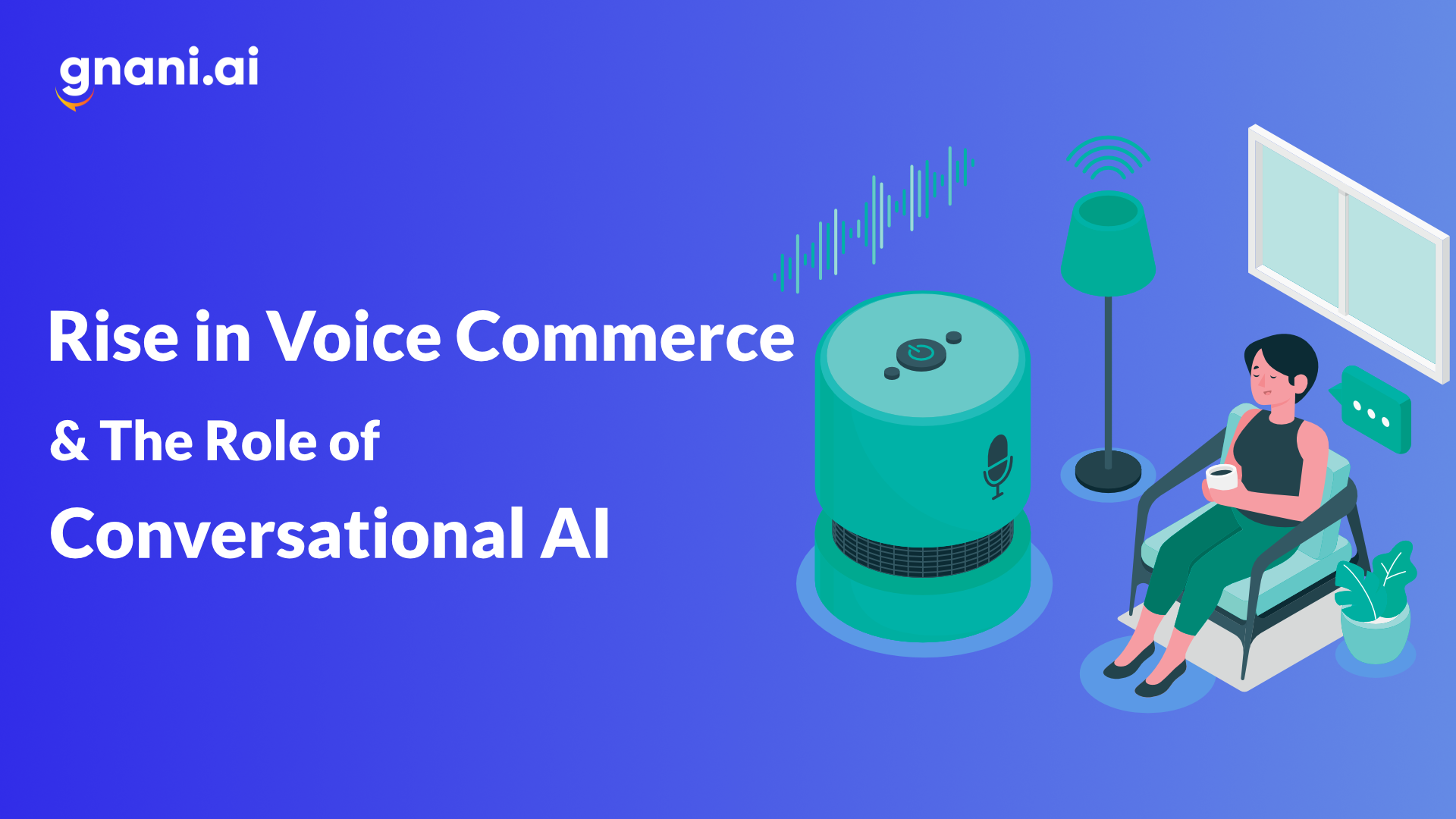Rise in Voice commerce & The Role of Conversational AI in it
“Hey Alexa, buy more detergent powder”
That’s mostly it and you’re done shopping! Over the past few years, e-commerce has evolved to be one of the primary modes of shopping. And now, consumers don’t even have to sit and type names to search for products and services. According to the Digital 2021 report, the increases in e-commerce adoption since the start of the COVID-19 pandemic show no signs of abating, even as movement restrictions come and go.
Lockdown-inspired behaviors have also endured, although people are slowly coming out of their homes. For example, almost 3 in 10 of us (28.3%) now buy groceries online every week, with the absolute number of online grocery shoppers increasing by 10% in just the past 6 months. Data from GWI shows that nearly 6 in 10 working-age internet users (58.4%) now buy something online every week, with that figure continuing to rise throughout 2021. For context, the latest data indicate that 424 million users started their social media journey over the past year, equating to an average of more than 1 million new users per day, or roughly 13½ new users every single second.
Conversational AI plays a crucial role in voice commerce by enabling virtual assistants to understand and respond to natural language requests from consumers. With the help of natural language processing (NLP) and machine learning (ML) techniques, conversational AI can understand the intent behind a customer’s voice command and provide personalized recommendations and responses. It can also help in order tracking, payments, and customer service, enhancing the shopping experience. Overall, the integration of conversational AI in voice commerce is helping to make the shopping experience more seamless and convenient for consumers.
What does this mean for business owners who are still unsure about their voice commerce strategy? Adoption.
The rise in voice commerce indicates that more and more consumers are turning to voice-enabled devices to make their purchases.This trend will only continue in the coming years, making it crucial for business owners to start thinking about their voice commerce strategy. One of the key components of a successful voice commerce strategy is conversational AI. This technology can help personalize the shopping experience for customers and make it more seamless, increasing the likelihood of a sale. Business owners still unsure about their voice commerce strategy should consider the adoption of conversational AI to stay competitive in the market. It’ll be like a personal attendant who will take care of all the shopping needs of consumers. As such, it looks like voice shopping is here to stay because apart from helping consumers shop as and when they remember, it is saving them time and effort as well. Virtual assistants such as Amazon’s Alexa, Apple’s Siri, and Google Assistant are examples of voice assistants that are successfully handling voice queries.
Benefits of Voice Commerce:
Voice commerce, also known as voice-enabled shopping, is a rapidly growing trend in the e-commerce industry. The rise of voice assistants like Amazon’s Alexa and Google Home, as well as the increasing popularity of smart speakers, has made it easier for consumers to shop using voice commands. This has led to an increase in voice commerce as more and more people are turning to this convenient and intuitive way of shopping.
There are proven and emerging benefits of voice commerce for both consumers and business owners including:
Personalization – No prizes for guessing this one. Today’s consumers are ferociously demanding of personalization. Since voice commerce is mainly driven by data, it enables consumers to list their choices, get answers to their questions and recommendations based on their shopping behavior to complete their shopping quickly. For business owners, it can translate into insights for developing new products that satisfy consumers’ needs and implementing marketing strategies that create a preference in the minds of customers for their products and services.
Convenience – Voice shopping allows consumers to multi-task. It helps them get quick answers, clear confusion, and enable them to shop faster while tending to other tasks. With an assistant at their beck and call, the daily routine of consumers becomes easier to handle. One of the most basic advantages of adopting voice commerce for business owners is the ease of adoption. With the right technology partner, there is no complex software or setup needed.
Safety – Voice commerce is making its way as a verification tool for safe checkouts. Because it makes it almost impossible for theft to occur, shoppers get their peace of mind. Business owners also benefit by having to worry less about keeping up with compliance regulations.
Loyalty – This is for business owners, mostly. For example, a customer loves Rothy’s shoes. Whenever she needs shoes, all she has to do is use Rothy’s voice assistant to suggest options based on her preferences, narrow down her choice and even assist in closing the purchase from her favorite brand. The consumer is happy and the Brand retains its loyal client, providing an extra layer of convenience to the overall experience.
With more and more evidence that points out an increasing usage of voice commerce by both businesses (especially the large ones) and consumers, brands will benefit by looking where voice assistants can improve the consumer journey. A piece of in-the-moment advice on cooking, for example, could smoothen the path to purchase. Not being able to deploy their voice assistants is no longer a challenge for enterprises because today, there are solutions available in the market that can be deployed per their specific needs. These enable them to interact with the modern consumer with their multilingual capability, understanding of the nuances of languages to help businesses to cater to a much broader customer group.
Okay Google, Why Should Businesses Implement Voice Commerce?
To quote this report, a voice-search option is turning out to be highly lucrative for online businesses. So much so that many of them are upgrading and optimizing their e-commerce websites to work with voice. Juniper Research gave an insight – voice-based ad revenue is projected to reach $19 billion by 2022.
As mentioned above, Voice-driven shopping helps brands share personalized suggestions and accelerate business on their websites. A voice assistant can also remind consumers about products they’ve bought earlier and may want to buy again.
A study of voice-based online buying practices conducted by Coupon Follow found that:
- Online shoppers who used voice spent an average of $136 more than people who solely shopped online
- About a third of “avid online shoppers” use voice to buy something at least once a month
Implementing a voice bot is simple, thanks to advanced technology-based options that are available today. Creating a custom voice bot can take months of hard work and high costs. It is faster and easier to engage a partner who understands the market and can deploy a voice bot per their specific needs. What’s even better is that there is zero need to understand coding to enable voice commerce. Furthermore, the use of conversational AI in voice commerce allows for personalized recommendations and a more natural and intuitive shopping experience. Sensibly designed Low-Code Voice Builder platforms like assit365™, makes building AI-powered bot easier for business owners. All you have to do is to—
- Choose from premade templates to make the bot builder’s job simpler
- Drag and drop the conversation modules based on your business requirements
- Deploy and test the bot
- Easily share with your team, collaborate, and complete the bot.
- Deploy the bot on your website, app, and on other platforms.
Overall, implementing voice commerce can give businesses a competitive edge and drive growth in their e-commerce sales.
In Summary
In conclusion, the rise of voice commerce presents a significant opportunity for businesses to improve customer experience and drive sales. By implementing voice commerce and utilizing conversational AI, businesses can stay ahead of the curve and offer their customers a cutting-edge shopping experience.
Research from GWI reveals that the “typical” global internet user now spends almost 7 hours per day using the internet across all devices. Imagine now the experience that Brands can deliver by injecting the right solutions at the right time coupled with an instant voice-based shopping facility. Voice assistants are increasingly becoming a part of consumers’ daily lives. The age of touch is now shifting to the age of voice. When bigger brands like Amazon and Walmart are using this to make shopping easier for their consumers, smaller businesses, too, must adopt it now because consumers are going to expect the same from them very soon.
Frequently Asked Questions
What are the benefits of AI-powered voice shopping?
Benefits of AI-powered voice shopping include a more personalized shopping experience, increased convenience, and improved efficiency.
How can companies implement AI-powered voice shopping in their business?
Companies can implement AI-powered voice shopping by integrating it into their existing e-commerce platform, using AI-powered voice shopping APIs, or partnering with AI-powered voice shopping providers.
What are the potential limitations of AI-powered voice shopping?
Potential limitations of AI-powered voice shopping include the need for accurate data input and training, and the potential for misunderstandings between customers and the AI system.





